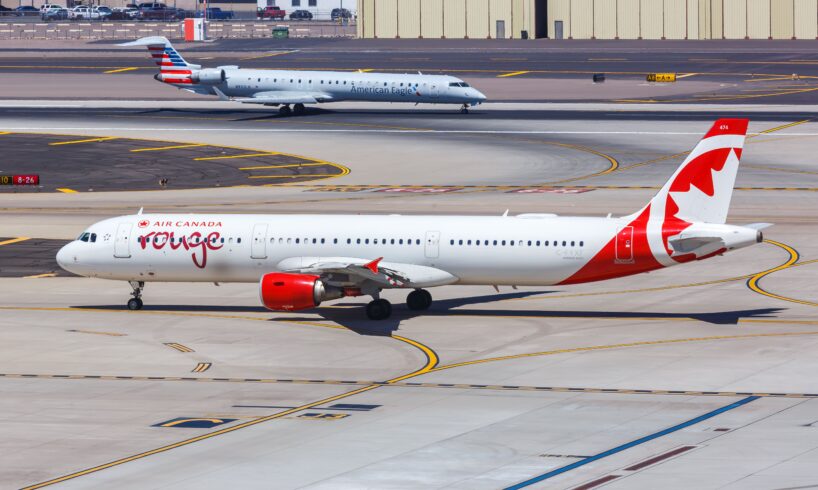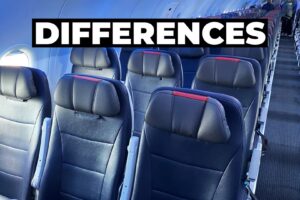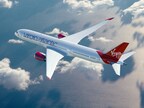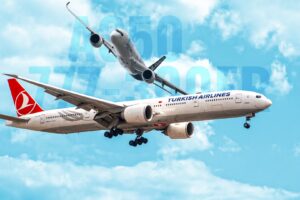
One of the worst emergencies that an aircraft could face midair is the possibility of an onboard fire. Even the slightest of indications, such as a cockpit alarm, haze, or smoke, is enough for the cockpit crew to take immediate action and land the plane at the nearest available airport.
That is exactly what happened on a recent Air Canada Rouge flight traveling from Harry Reid International Airport in Las Vegas to Toronto Pearson International Airport. The Airbus A321 aircraft made an emergency landing at Des Moines, Iowa, after its cabin started smelling of smoke. Thankfully, no passenger injuries were reported in the incident.
Smoke Detected In Cockpit Of Air Canada Rouge A321
Photo: Flightradar24
On April 16, an Air Canada Rouge
flight flying from Harry Reid International Airport (LAS) in Las Vegas to Toronto Pearson International Airport (YYZ) had to be diverted to Des Moines International Airport (DSM) in Iowa because pilots noticed smoke in the cockpit. It started out as a routine flight, and data shows that the Airbus A321
was cruising at an altitude of 35,000 feet and had covered more than half of its journey when it was seen making the detour.
According to Flightradar24, the A321 was seen descending as it approached Des Moines. Instead of heading north towards Canada, the aircraft was seen turning right, followed by another sharp right turn towards the airport. The decision to divert was taken “out of an abundance of caution.” There were 176 passengers onboard, and all of them disembarked safely without any injuries. One of the passengers said that the entire plane smelled like smoke. According to Des Moines Airport, the A321 landed at around 16:00 local time. CBC News quotes a statement from Air Canada:
“The A321 aircraft landed normally and as per standard procedure, was immediately evaluated after landing by airport response teams, and then cleared to taxi to the gate.”
About The Flight And Aircraft
Photo: Rix Pix Photography | Shutterstock
The aircraft was performing flight AC1702, a daily scheduled service between Las Vegas and Toronto. It has a departure time of 11:10 and an arrival of 18:29. The flight usually takes around four hours to complete. It has been reported that Air Canada was making arrangements to fly another aircraft to Des Moines to pick up the stranded passengers to bring them back to Toronto.
The plane involved in the incident is an Airbus A321ceo registered as C-FJQL. According to data by ch-aviation, it is 8.94 years old and was delivered in May 2016. The carrier operates it on lease from AviLease. The A321 can accommodate 196 passengers in economy and business class. As of January 2025, it has accumulated almost 24,000 flight hours across 7,512 flight cycles.
A subsidiary of Air Canada, Air Canada Rouge operates low-cost flights in the region with an all-Airbus aircraft fleet. The airline depends upon the A320 family of aircraft to carry out domestic and short-to-medium-haul international flights, and its current fleet structure looks like the following:
Aircraft type
Active
Inactive
Total
A319-100
18
18
A320-200
4
1
5
A321-200
14
2
16
Related
How Are Aircraft Designed To Mitigate The Effects Of Cargo Hold Fires?
Fire suppression systems feature multiple redundancies.
Dangerous Situation
Photo: Dzerkach Viktar | Shutterstock
An fire is one of the most dangerous onboard emergencies that an aircraft can face. After the Air Canada Rouge jet landed in Des Moines, firefighters used an infrared camera to try to find the cause of the smoke, but were unsuccessful.
Still, airlines around the world have strict protocols when it comes to smoke detection in the cabin and the things that can be carried inside the airplane, including the cargo hold. Thankfully, the cargo holds of modern planes use composite linings and advanced fire suppression systems to minimize fire risks and improve passenger safety. This has been done keeping in mind multiple instances in the past where fire in the cargo hold led to the crash of an airliner.
New-generation planes such as the Airbus A350
use fire-resistant composite structures in their fuselage, wings, and other critical exterior and interior components. Airbus applies fire, smoke, and toxicity requirements to the aircraft interior elements, and the thermal heating, degradation, burning, and physical morphology of composite materials are also better than aluminum, making the new planes somewhat better equipped to deal with fire.





